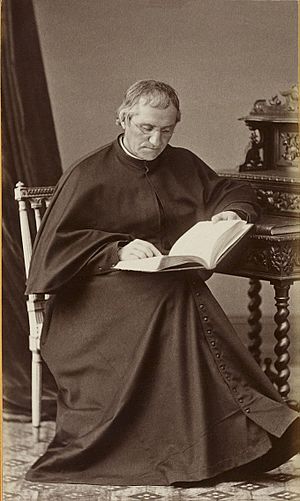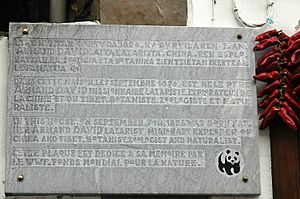Armand David facts for kids
Quick facts for kids Armand David |
|
|---|---|
 |
|
| Church | Catholic Church |
| Orders | |
| Ordination | 1851 |
| Personal details | |
| Birth name | Jean-Pierre-Armand David |
| Born | 7 September 1826 Espelette, France |
| Died | 10 November 1900 (aged 74) Paris, France |
| Denomination | Roman Catholicism |
| Occupation | Biologist |
Father Armand David (born September 7, 1826, in Espelette, France – died November 10, 1900, in Paris, France) was a Catholic priest. He was also a famous zoologist (someone who studies animals) and a botanist (someone who studies plants). He belonged to a group called the Lazarists. Many animals and plants, like Père David's deer, are named after him. Père David means Father David in French.
Contents
Armand David's Life and Discoveries

Armand David was born in Espelette, a town near Bayonne in the Basque Country region of France. From a young age, he loved studying nature.
In 1848, he joined the Congregation of the Mission, a group of Catholic priests. He became a priest in 1851. In 1862, he was sent to Peking, China. There, he started collecting many different things for a museum of natural history. He collected mostly animals, but also plants, rocks (for geology), and fossils (for palaeontology).
The French government asked for some of his important collections to be sent to Paris. These items were very interesting to scientists. Because of this, the Jardin des Plantes (a famous garden and museum in Paris) asked him to go on more trips across China. His goal was to find and collect even more unknown animals and plants.
Father David was very successful. He found many new kinds of animals and plants that Europeans had never seen before. His collections helped scientists learn a lot about the animals and plants of China. He found 200 types of wild animals, and 63 of them were new to scientists. He also found 807 types of birds, with 65 being new discoveries.
He collected many reptiles, amphibians, and fishes. He also gathered a large number of moths and insects, many of which were new. These were all sent to the museum in Paris. For botany (the study of plants), Father David's trips were also very important. For example, he collected 52 new types of rhododendrons and about 40 new types of primulae. He also found many new kinds of gentian flowers in the mountains of China.
Some of his most famous discoveries include the giant panda and Père David's deer. He found the giant panda in Baoxing County. The Père David's deer was almost extinct, with only a few living in the Chinese emperor's gardens. Father David managed to get a specimen and sent it to Europe, helping to save the species. He also sent back the first emerald ash borer insect specimen.
Even though he was very busy with his scientific work, Father David always remembered his duties as a missionary priest. He was known for being very dedicated to his religious work and following the rules of his order.
Things Named After Armand David
Many plants and animals have been named in honor of Father Armand David. This is called "eponymy."
- The plant Buddleja davidii (also known as the butterfly bush) was named for him.
- The Ulmus davidiana, or David Elm tree, is also named after him.
- The fish Sarcocheilichthys davidi was named in his honor in 1878 by Henri Émile Sauvage, because Father David collected the first one.
- Père David's Rat Snake (Elaphe davidi) was named after him in 1884 by Henri Émile Sauvage.
See also
 In Spanish: Armand David para niños
In Spanish: Armand David para niños
- Catholic Church in Sichuan
- Catholic Church in China
- Jesuit China missions
- List of Roman Catholic scientist-clerics
Catholic missionaries in China
- Michel Benoist
- Giuseppe Castiglione
- Armand David
- Matteo Ricci
- Johann Adam Schall von Bell
- Ferdinand Verbiest
- St. Francis Xavier
Eponymous taxa
- Père David's tit
- Père David's deer
- Davidia involucrata
- Père David's snowfinch
- Père David's mole
- Père David's owl
- Père David's vole
- Père David's rock squirrel
- Père David's laughingthrush
- Andrias davidianus
- Clematis armandii
- Buddleia davidii
- Viburnum davidii
- Acer davidii

